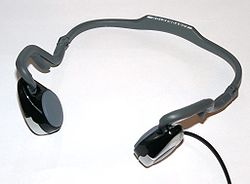
Bone conduction
Encyclopedia

Sound
Sound is a mechanical wave that is an oscillation of pressure transmitted through a solid, liquid, or gas, composed of frequencies within the range of hearing and of a level sufficiently strong to be heard, or the sensation stimulated in organs of hearing by such vibrations.-Propagation of...
to the inner ear
Ear
The ear is the organ that detects sound. It not only receives sound, but also aids in balance and body position. The ear is part of the auditory system....
through the bone
Bone
Bones are rigid organs that constitute part of the endoskeleton of vertebrates. They support, and protect the various organs of the body, produce red and white blood cells and store minerals. Bone tissue is a type of dense connective tissue...
s of the skull
Human skull
The human skull is a bony structure, skeleton, that is in the human head and which supports the structures of the face and forms a cavity for the brain.In humans, the adult skull is normally made up of 22 bones...
.
Bone conduction is the reason why a person's voice sounds different to him/her when it is recorded and played back. Because the skull conducts lower frequencies better than air, people perceive their own voices to be lower and deeper than others do. This also explains why a recording of one's own voice sounds higher than one is accustomed to.
Some hearing aid
Hearing aid
A hearing aid is an electroacoustic device which typically fits in or behind the wearer's ear, and is designed to amplify and modulate sound for the wearer. Earlier devices, known as "ear trumpets" or "ear horns", were passive funnel-like amplification cones designed to gather sound energy and...
s employ bone conduction, achieving an effect equivalent to hearing directly by means of the ears. A headset is ergonomically positioned on the temple and cheek and the electromechanical transducer, which converts electric signals into mechanical vibrations, sends sound to the internal ear through the cranial bones. Likewise, a microphone can be used to record spoken sounds via bone conduction. The first description, in 1923, of a bone conduction hearing aid was Hugo Gernsback
Hugo Gernsback
Hugo Gernsback , born Hugo Gernsbacher, was a Luxembourgian American inventor, writer, editor, and magazine publisher, best remembered for publications that included the first science fiction magazine. His contributions to the genre as publisher were so significant that, along with H. G...
's "Osophone", which he later elaborated on with his "Phonosone".
Bone conduction products are usually categorized into three groups
- Ordinary products such as hands-free headsets or headphones
- Hearing aids and assistive listening devices
- Specialized communication products (e.g. underwater & high-noise environments)
Bone conduction products have following advantages over traditional headphones:
- Ears-free, thus providing extended use comfort and safety
- High sound clarity in very noisy environments, can be used with hearing protection
- Can have the perception of stereo sound
There are some disadvantages:
- Some implementations require more power than headphones
- Less clear recording & playback than traditional headphones and microphone due to reduced frequency bandwidth
One example of a bone conduction speaker is a rubber over-moulded piezo-electric flexing disc about 40mm across and 6mm thick used by scuba divers
Scuba diving
Scuba diving is a form of underwater diving in which a diver uses a scuba set to breathe underwater....
. The connecting cable is moulded into the disc, resulting in a tough, water-proof assembly. In use the speaker is strapped against one of the dome-shaped bone protrusion behind the ear. As would be expected, the sound produced seems to come from inside the user's head, but can be surprisingly clear and crisp.
Bone conduction transmission can be used with individuals with normal or impaired hearing. There are several products on the market that exploit the bone conduction transmission pathway for sound. Some of these include the AquaFM and the SwiMP3 which are devices for transmitting sound to swimmers.
See also
- Bone conduction auditory brainstem responseBone conduction auditory brainstem responseBone-conduction auditory brainstem response or BCABR is a type of auditory evoked response that records neural response from EEG with stimulus transmitted through bone conduction.-Types of bone conduction:...
- Bone Anchored Hearing AidBone Anchored Hearing AidA Bone-anchored hearing aid is a type of hearing aid based on bone conduction. It is primarily suited to people who have conductive hearing losses, unilateral hearing loss and people with mixed hearing losses who cannot otherwise wear 'in the ear' or 'behind the ear' hearing aids...
- Bonephones
- Cochlear BahaCochlear BahaThe Baha is a bone conduction hearing system designed, developed and marketed by Cochlear. When Cochlear bought the Swedish company Entific Medical Systems in 2005, the acronym BAHA was trademarked into Baha, since it is not considered a hearing aid by insurance companies.The Baha is a...

